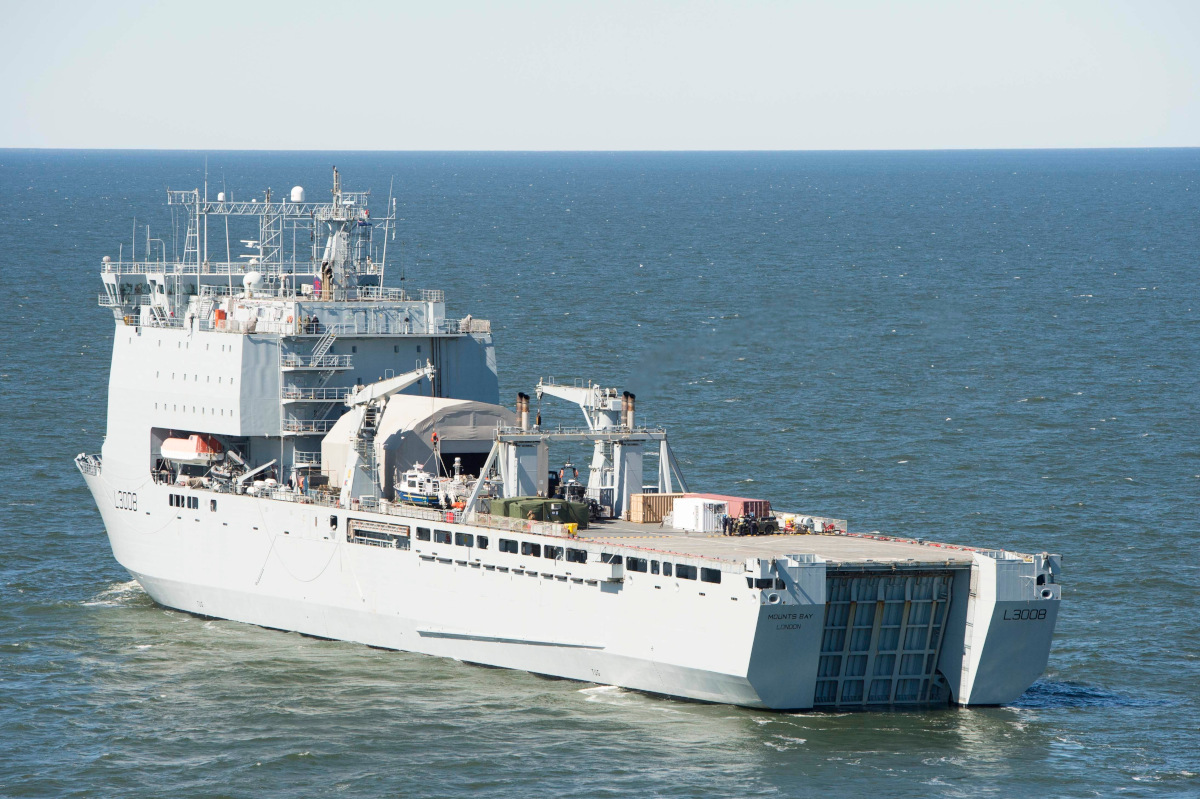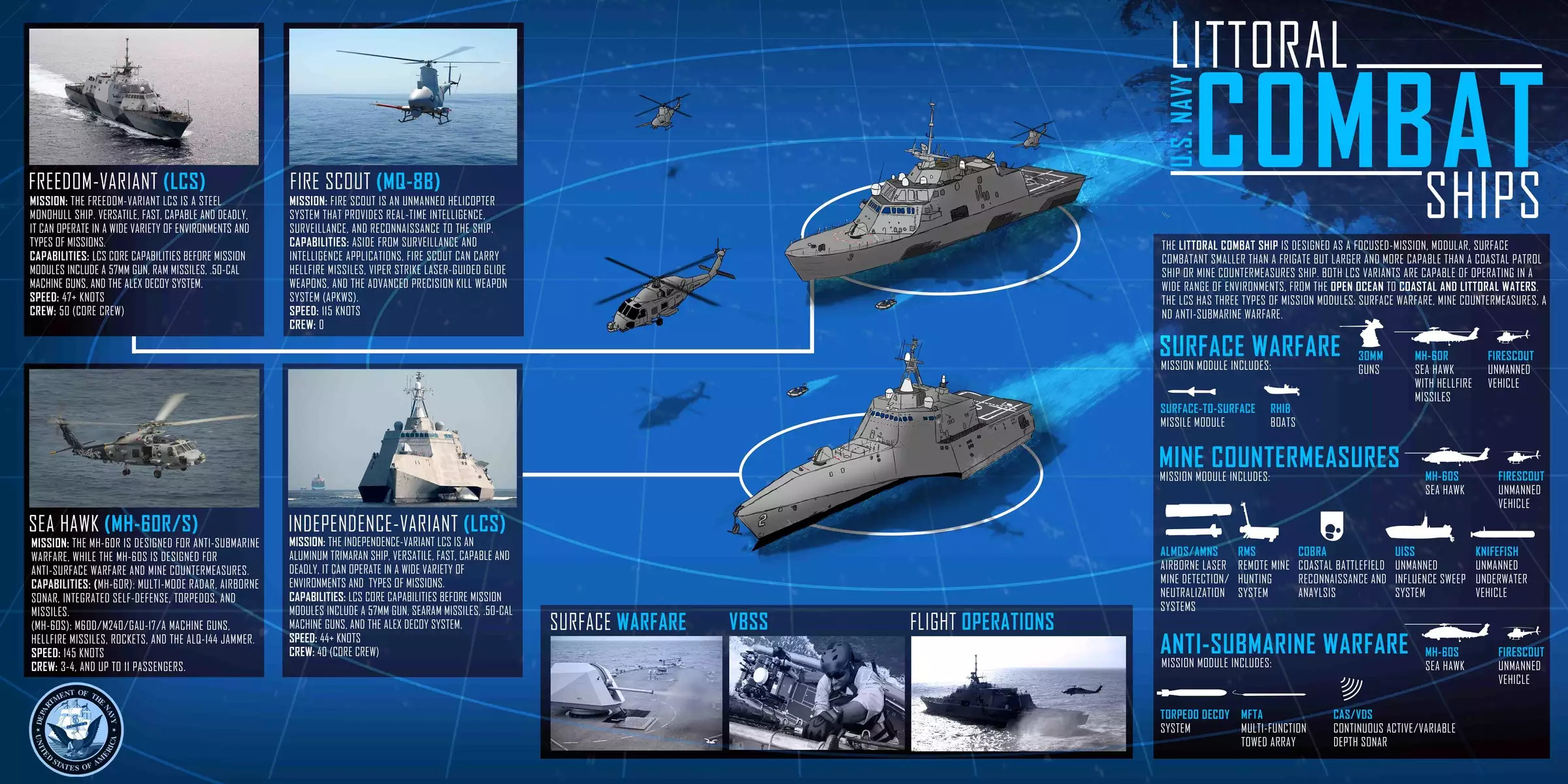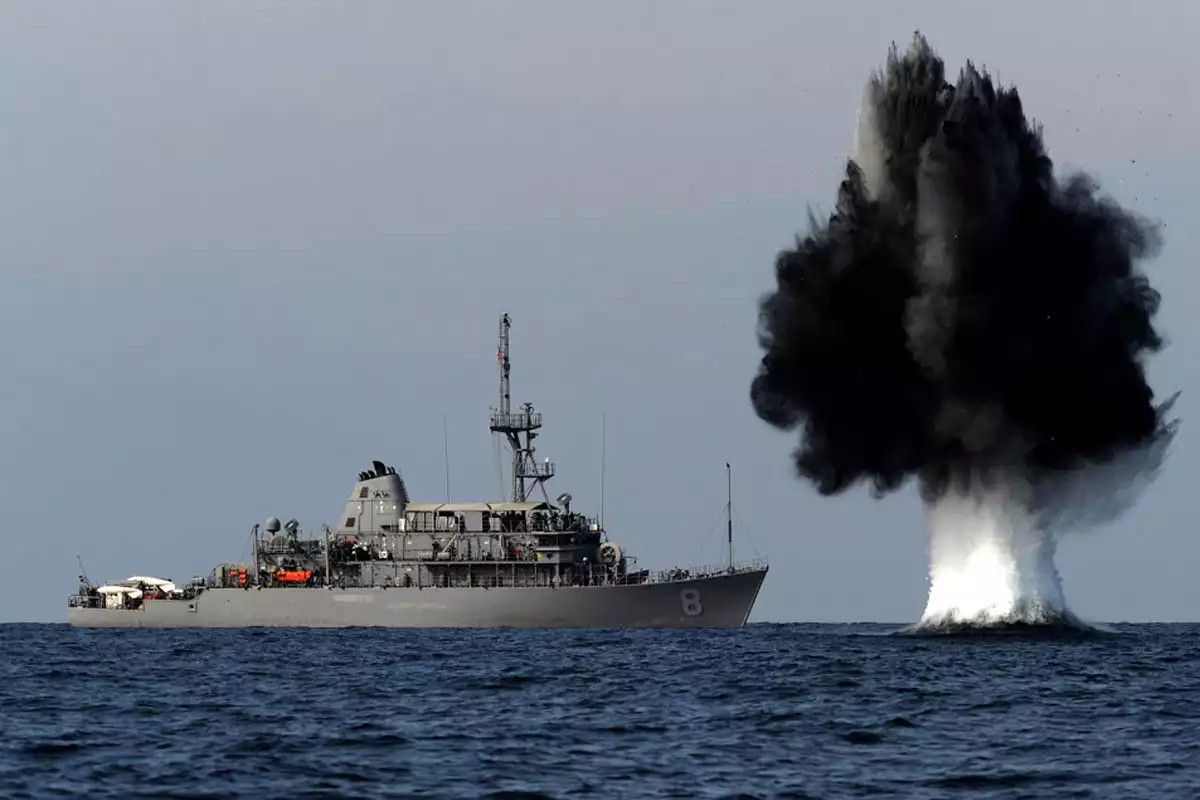The U.S. Navy and the U.K. Royal Navy recently conducted an experiment involving deploying a specialized minesweeping task force, which included unmanned surface and undersea vehicles, onboard a British amphibious ship. The idea of using “vessels of opportunity” to host counter-mine forces is an important component of the U.S. Navy’s plan for reaching a fleet size of 355 ships in the next 15 years. This test also demonstrates how the concept could leverage non-combat and allied vessels for these missions in the future.
The Navy’s Explosive Ordnance Disposal Mobile Unit Two (EODMU 2) led the American group of almost 120 personnel on board the Royal Fleet Auxiliary’s landing ship dock RFA Mounts Bay. The experiment, which occurred in the Caribbean Sea, ran from Mar. 18 through Mar. 24, 2019. Mounts Bay is in the midst of a three-year forward deployment in the region, where it is available to support humanitarian and disaster relief missions, counter-narcotics operations, and otherwise engage with the United Kingdom’s regional partners, including the United States.
“To embark all of those players onto one platform, an allied platform nonetheless, to integrate them all from a central hub, and to deconflict them from one task group is what we were looking to accomplish,” U.S. Navy Commander Jon Haase, head of EODMU 2, said afterward. “This was an opportunity to exercise command and control of a mine countermeasures task group so we could refine and advance both our ability to command and control but also our understanding of how the systems would work together off a vessel not designed for them.”

The mine countermeasures task group main contingent was from EODMU 2, who train to clear mines, improvised explosive devices, and similar threats at sea and on land. It also included an MH-60S Sea Hawk helicopter from Helicopter Sea Combat Squadron Two Eight (HSC-28) and personnel from Littoral Combat Ship Squadron Two (LCSRON 2) to support the employment of a Common Unmanned Surface Vehicle (CUSV) and multiple Knifefish unmanned undersea vehicles (UUV).
The MH-60S was based ashore during the experiment, but did fly missions from the Mounts Bay. During the test, the helicopter employed both the AN/AES-1 Airborne Laser Mine Detection System (ALMDS) and the AN/ASQ-235 Airborne Mine Neutralization System – Archerfish (AMNS-AF).
Northrop Grumman’s ALMDS uses a laser imaging system to generate imagery that highlights potential objects of interest, such as mines, both on the surface and just below the waves. The full system can then classify and geo-locate those threats for other systems can neutralize them.

The MH-60S itself can carry one such system to defeat those mines, the AMNS-AF, which Raytheon and BAE Systems have collaborated on to deliver to the U.S. Navy. The Archerfish system involves a cradle that the helicopter carries with four expendable interceptors.
After the helicopter releases an Archerfish, it remains tethered to the helicopter, providing a fiber optic data link to an operator on board. That individual then manually steers it to the target using a camera feed from the interceptor, which also contains an armor-piercing explosive charge to destroy the threat.
The video below shows a test of Archerfish launched from an unmanned undersea vehicle, which could be another combination the U.S. Navy might be interested in acquiring in the future.

The Knifefish Unmanned Undersea Vehicles (UUVs), which carry a synthetic aperture sonar, are another means of detecting mines, especially those that might be submerged at depths beyond where airborne systems such as the ALMDS can scan, or that are buried or partially buried on the seafloor. The underwater drone also has the ability to classify and locate items of interest for further investigation or neutralization.
The last major system in this recent test, Textron’s CUSV, is part of a still-under-development unmanned minesweeping system known as the Unmanned Influence Sweep System (UISS). The UISS will consist of the drone boat pulling a mine-clearing system that triggers acoustic and magnetic naval mines, or mines that use a combination of those features.

Embarked EODMU 2 personnel also had the ability to manually inspect possible mines and other hazards above and below the waves if necessarily. Mounts Bay is an ideal platform to support this mix of systems, given that the ship, which displaces around 16,000 tons, has a relatively large flight deck for helicopters, a well deck to launch larger boats, and the ability to launch smaller watercraft from bays on its sides.
Able to carry more than 350 troops and their equipment on more traditional amphibious missions, it has ample space to house the various drone control and other necessary facilities to host the mine-clearing force. Earlier in 2019, Mounts Bay used this capacity to hosted a U.S. Coast Guard force, including a law enforcement detachment and an MH-65 helicopter from the Helicopter Interdiction Tactical Squadron, or HITRON, to conduct combined counter-drug missions in the Caribbean.

In general, the concept of using Mounts Bay as a minesweeping platform in many ways reflects what is now years of continuous Navy experience. For nearly a decade straight now, the service has been using amphibious ships, and now dedicated sea bases, as floating platforms to support countermine operations. This began with the overhaul of the USS Ponce in 2011, which you can read about in more detail here, and has since evolved into a small fleet of purpose-built Expeditionary Sea Base vessels.
The full package the U.S. Navy embarked on the ship also combined the bulk of the systems the service had developed for the mine countermeasures mission module for the Littoral Combat Ships (LCS). The service originally planned for ships in both LCS classes to be able to rapidly swap out these different mission modules to fill different roles as necessary, but has steadily moved away from this concept. It now expects to designate eight LCS ships as permanent platforms for the minesweeping systems.

The problem is that the this is not a one-for-one replacement for the 11 remaining Avenger-class minesweepers the Navy has in service now and is looking to have retired 2023. As such, the specially-equipped LCSs are unlikely to support the demand for mine countermeasures support in the future.
The threat of naval mines is only increasing in general and the Navy knows it will need more mine-sweeping support in the future, not less, especially during any major conflict across the wide expanses of the Pacific Region. But it is also looking to avoid having to purchase new minesweepers at the cost of other shipbuilding priorities over the next 30 years.

That’s where the “vessel of opportunity” concept comes in. The ability to readily embark a mine countermeasures force package on any available ship could help ease the strain on the service’s shrinking number of dedicated minesweeping ships and increase the flexibility of those assets. Utilizing non-combat ships, such as Military Sealift Command’s sealift fleet, whenever possible could also help free up combat vessels for their primary missions.
The U.S. Navy and Marine Corps have been increasingly exploring how MSC’s fleets might be able to support new and emerging roles. It’s also worth noting that the Royal Fleet Auxiliary serves a largely non-combatant role, similar to MSC, in support of the Royal Navy.
Beyond that, leveraging any allied platforms, such as the Mounts Bay, could further expand the options available to the Navy, particularly on short notice. This would also help ensure the service has the ability to rapidly deploy counter-mine forces even if it has no vessels of opportunity of its own nearby.
With the increasing proliferation of naval mines, including among non-state actors, such as Houthi rebels in Yemen, these threats could rapidly emerge with little advance warning. Beyond the obvious threat to American warships during more traditional combat operations, the sudden appearance of minefields in major shipping lanes could quickly have major geopolitical and economic impacts.

A prime example is the Strait of Hormuz, which links the Persian Gulf to the Gulf of Oman and then on the Arabian Sea. Iran routinely threatens to blockage this passage, through which 20 percent of all the world’s oil exports flow and that serves as a transit route for 90 percent of all of the region’s energy exports, including natural gas.
It still remains to be seen whether the vessels of opportunity concept will be as workable as the Navy hopes. While the plan might help avoid the need to have dedicated ships available, it will still require the service to have the mine-clearing force packages ready to go onto an available vessel on short notice.
Each of its fleets around the world does have these elements organically, but that doesn’t ensure they’ll be close to the vessel of opportunity when the time comes or that there will be enough of them to meet demand at current force levels. Pre-positioning sufficient assets to support the plan could be costly and resource intensive in its own way, especially given the Navy’s persistent personnel shortages.
Minesweeping is also a complex, time-consuming, and risky mission that demands both significant training and benefits greatly from expertise. The systems involved, such as the mine countermeasures equipment for the MH-60S and unmanned surface and undersea vessels, also require specialized support, as was clear from this latest experiment.

These issues already called into question just how effective an LCS equipped with the mine countermeasures module might be unless its crew received more intensive training in the mission to go along with it. Mine-clearing task forces may similarly have trouble rapidly integrating with just any ship on a moment’s notice. If a lengthy workup is necessary to get everyone on the same page before a vessel of opportunity can set sail for a minesweeping mission, the entire idea may prove to be far less flexible than the Navy might hope.
The Navy is also looking toward developing additional minesweeping tools that could help provide added counter-mine capacity and mitigate some of the issues with the vessels of opportunity concept. These efforts notably include high-endurance, autonomous unmanned surface and undersea vehicles that can operate across a larger area than something such as the CUSV and do so with more limited support from manned vessels.
These are all issues the Navy will have to consider going forward in order to validate the concept and ensure it succeeds. It seems safe to assume that we will be seeing more experiments, like the recent one with Mounts Bay, in the near future.
Contact the author: jtrevithickpr@gmail.com
